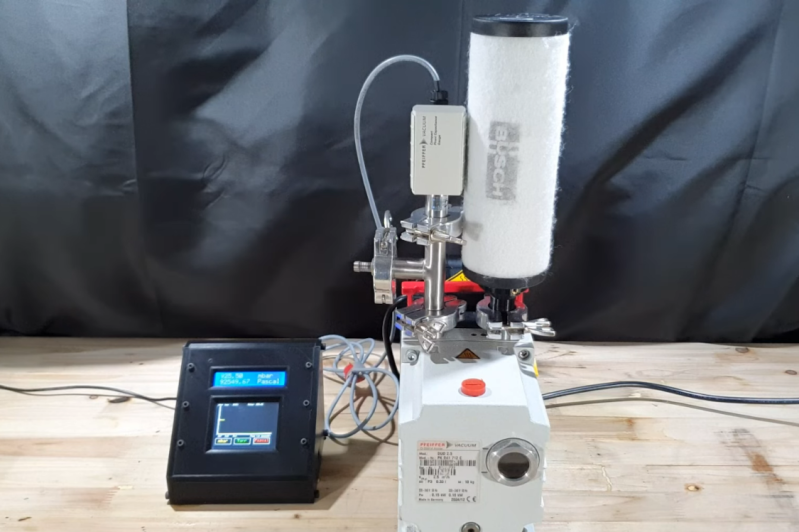Necessity might be the mother of all invention, but we often find that inventions around here are just as often driven by expensive off-the-shelf parts and a lack of willingness to spend top dollar for them. More often than not, we find people building their own tools or parts as if these high prices are a challenge instead of simply shrugging and ordering them from a supplier. The latest in those accepting the challenge of building their own parts is [Advanced Tinkering] who needed a specialty pressure gauge for a vacuum chamber.
In this specific case, the sensor itself is not too highly priced but the controller for it was the deal-breaker, so with a trusty Arduino in hand a custom gauge was fashioned once the sensor was acquired. This one uses an external analog-to-digital converter to interface with the sensor with 16-bit resolution, along with some circuitry to bring the ~8 V output of the sensor down to the 5 V required by the microcontroller. [Advanced Tinkering] wanted a custom live readout as well, so a 3D printed enclosure was built that includes both an LCD readout of the pressure and a screen with a graph of the pressure over time.
For anyone else making sensitive pressure measurements in a vacuum chamber, [Advanced Tinkering] made the project code available on a GitHub page. It’s a great solution to an otherwise overpriced part provided you have the time to build something custom. If you’re looking for something a little less delicate, though, take a look at this no-battery pressure sensor meant to ride along on a bicycle wheel.















Title seems misleading. The pressure gauge wasn’t assembled inside a vacuum chamber. It was assembled *for* a vacuum chamber.
One of these would be an ideal input for a vacuum, or more correctly an absolute pressure sensor.
https://www.digikey.com/en/products/detail/honeywell-sensing-and-productivity-solutions/SSCDANN015PAAA5/2416079
Working a bit with high vacuum myself, I think the plastic enclosure and hose barb is more or less limiting it to the single Pascals and above.
And peering through the datasheet, the lowest pressure figure they give is 160 Pa.
Ie, we could use it to measure the pressure of our roughing pump.
However, a typical Pirani gauge however tends to go down to 0.1 Pa. Still a bit lack luster as far as “high vacuum” gauges go, since high vacuum starts at 1 Pa and goes down to about 1 µPa. An Ion gauge is more suitable here.
But low/medium vacuum and high vacuum is more or less different worlds, so the two aren’t directly comparable in most cases….
Hello,
i built the vacuum controller. The Datasheet mentions a measuring range of 5×10^-4 mbar to 1500 mbar. That would be 0.05 Pa. Where did you get the 160 Pa from?
The current setup is not meant for a high vacuum. Mostly for gas discharge tubes, distillation and similar applications. When switching to a higher vacuum I plan on using a diffusion pump and only KF flanges.
But which plastic enclosure do you mean?
Thank you!
I were talking about the datasheet linked by Tom Hargrave.
The pressure transducer made by Honeywell is going to be limited in real applications, the material is plastic, and it has a hose barb, neither of these are particularly ideal for vacuums bellow a few Pa.
And yes I do know your current setup isn’t meant for high vacuum, if it were, you wouldn’t use a Pirani gauge.
And yes, a Pirani gauge can go lower than 0.1 Pa, but usually not by much since it measures thermal conductivity of the gas and bellow 0.1 Pa there isn’t really much gas to speak off left. Thermal emission and conduction through the apparatus itself starts to throw in a wrench, and one needs increasingly better measurement resolution and calibration tables to follow.
Also, a quick piece of advice on diffusion pumps.
They are dirty as hell, and is going to coat everything in the chamber is a thin layer of oil. It doesn’t matter if one has water cooled baffles or not, baffles only reduces the amount spraying out the pump, they sure as hell don’t remove it. (since the oil still has a vapor pressure) So depending on what you are going to use the chamber for, this can either not matter, or it will make the experiment impossible.
Also, diffusion pumps can go to “high vacuum”, if one ignores the vapor pressure of the oil. Pressure of all other gases can be a true high vacuum, but the chamber can still read higher due to the oil. (This obviously depends on the vapor pressure of the oil. But around 10-0.01 mPa isn’t unexpected, unless contaminated. (a lot of these oils absorbs water like a sponge in my experience….))
Turbomolecular pumps are however their own hassle, and usually expensive as hell and have a large risk of exploding if the chamber suddenly decides to leak or something starts outgassing all of a sudden…
I understand. Thanks for the more detailed explanation.